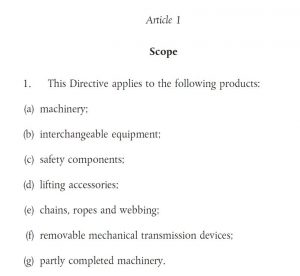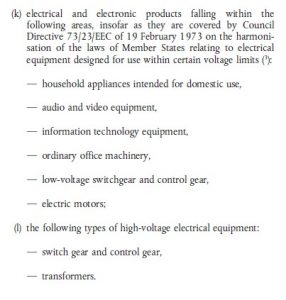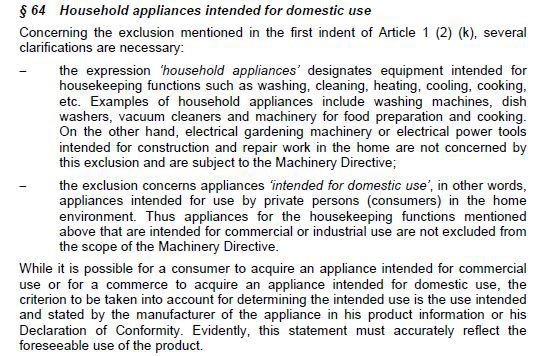Previously we discussed some of the legal questions about compliance to either the Machinery Directive 2006/42/EC or the Low Voltage Directive 2014/35/EU.
This one question has led to many discussions at F2. Usually it starts with, “well, does a cooling fan on a computer mean that a computer is a machine?” And it’s all down hill from there. We have an overview of the Machinery Directive for review on our site. Sometimes though it is helpful to read straight from the Directive itself. Let’s take a closer look.
The Machinery Directive 2006/42/EC lists the scope of applicability in Article 1. See below.

And in Article 1 (2) it lists equipment which is excluded from its scope.

The reference to 73/23/EEC is a reference to the Low Voltage Directive that was law when the Machinery Directive was first published, back in 2006. By law, that reference is applicable to the currently valid Low Voltage Directive, which is the Low Voltage Directive 2014/35/EU.
OK, so what does this mean? It means that machinery, defined broadly in the Machinery Directive in Article 2 (a) as…

… but also falls into the categories set out in Article 1 (2) (k) can claim compliance to the Low Voltage Directive 2014/35/EU and not the Machinery Directive 2006/42/EC. This would be beneficial, immediately, because then the manufacturer would not need to add a European address on the EU declaration of conformity. It also means that a manufacturer will comply with Annex I from the Low Voltage Directive and not Annex I from the Machinery Directive, which is much longer and more detailed. It also means that less EN standards will be involved in the compliance process. In short, an evaluation to the Low Voltage Directive is preferable to an evaluation to the Machinery Directive.
Note, however, that you cannot just select the Low Voltage Directive if a product ‘could’ be used in the household or in an office. The product has to be specifically dedicated for the use(s) indicated in Article 1 (2) (k). To better understand this, we will review what the writers of the Machinery Directive clarified in the Guide to application of the Machinery Directive 2006/42/EC.
Section 63 of the Guide indicates basic interpretive guidance.

Then it goes into much greater detail regarding each of the previously referenced available exclusions. It is illuminating to read all of the sections but we will focus on section 64.

Notice that the product must be intended for domestic (household) use. Clearly this means that you cannot twist the exclusion to benefit a machine that could be used in the home. It must be intended for home use.
Additionally, please read the last paragraph. This makes it clear that the Market Surveillance Authorities have the option to review product brochures, your website, the manual, etc to glean the intended use for the product. In practical application this means that if your product is a commercial floor cleaner, marketed for commercial use – you cannot eliminate the Machinery Directive 2006/42/EC from your compliance path and claim it is a household product because it may be used in the home.
Have a question or a comment? We can be contacted via this link. We can be reached by phone at 877-405-1580 and are here to help you.u.

